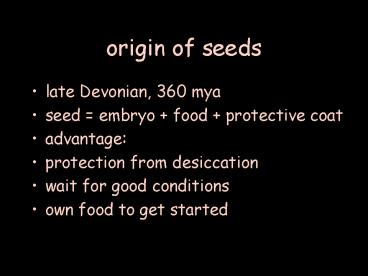origin of seeds - PowerPoint PPT Presentation
1 / 21
Title:
origin of seeds
Description:
today 11 genera 130 sp. tough leaves. look like ferns. but have cones w/seeds. roots assoc. ... 50 genera, 550 sp. most evergreen. needle leaves adapted for drought ... – PowerPoint PPT presentation
Number of Views:78
Avg rating:3.0/5.0
Title: origin of seeds
1
origin of seeds
- late Devonian, 360 mya
- seed embryo food protective coat
- advantage
- protection from desiccation
- wait for good conditions
- own food to get started
2
reproductive adaptations of seed plants
- gametophytes smaller
- female gametophyte retained on parent sporophyte
- male gametophyte transports sperm
- water not required for fertilization
- seeds are means of dispersal
3
2 types of seed plants
- 1. Gymnosperms naked seeds
- seeds exposed (on cones)
- 2. Angiosperms vessel seeds
- seeds inside fruits
4
gymnosperm life cycle
- heterospory w/2 types of cones
- 1) small cones w/microsporangia
- microspores develop into pollen
- pollen immature male gametophyte
- reduced in sizeno antheridia
- whole gametophyte travels (pollination)
- fertilization without water
5
gymnosperm life cycle
- 2) large cones have megasporangia
- megasporangium protected by integuments
- ovule megasporangium integuments
- seed mature ovule
- integuments become seed coat
- megaspore stays in megasporangium
6
gymnosperm seedexample Pine
seed coat (2n)
female gametophyte (n)
embryo (2n)
embryo is new sporophyte female gametophyte is
stored food
7
pine life cycle
- 3 years to make seed
- pollination seed dispersal by wind
8
gymnosperms--cycads
- prominent w/dinosaurs
- today 11 genera 130 sp
- tough leaves
- look like ferns
- but have cones w/seeds
- roots assoc. w/cyanobacteria
- plants defended by toxic compounds
9
gymnosperms--Ginkgo
- only genus in group Ginkgophyta
- thought extinct
- good urban tree
- stinky seeds
- veins dichotomously branched
10
gymnosperms--Gnetophyta3 very different genera,
70 sp
- 1) Ephedra
- desert
- mormon tea
- ephedrine
11
gymnosperms--Gnetophyta
- 2) Gnetum
- tropical vine
- flat leaves
12
gymnosperms--Gnetophyta
- 3) Welwitschia mirabilis
- Namib desert, 2 leaves, 1500 yrs old
13
gymnosperms--conifers
- very successful. 50 genera, 550 sp
- most evergreen
- needle leaves adapted for drought
- small surface area, thick cuticle
- stomata sunken in valleys
14
Taxodium distichum bald cypress Heron Pond,
Cache River State Natural Area , S IL
deciduous relative of redwoods sequoias
15
- oldest plants
- Bristlecone Pines 4600 years old
16
gymnosperms--conifers
- most massive plants
- Giant Sequoia 26 m circumference, (8.3 m
diameter!) 3000 years old - tallest living plants
- Coast Redwoods 367 ft tall, 600-800 yrs old
- Watterson Towers only 281 ft
17
types of growth
- primary growth (up or down) shoot root apical
meristems - secondary growth (out) cambium meristem makes
shoot root thick
18
secondary growth
- vascular cambium
- xylem to inside, phloem to outside
- wood is secondary xylem
- cork cambium makes cork to outside
- bark cork phloem
- everything outside of vascular cambium
19
tree rings seasonal changes in xylem cell size
20
dendrochronology
- tree rings date historical events
- similar patterns in neighboring trees
- overlap rings to get complete record
- need consistent rings
- regular wet dry cycles
21
Plant tissue culture Fig 38.14
- plant cells are totipotent
- any cell can grow into whole new plant
- new plant is clone (same genes)
- examples leaf cutting, Wollemi Pine
- callus undifferentiated tissue
- balance of hormones required































